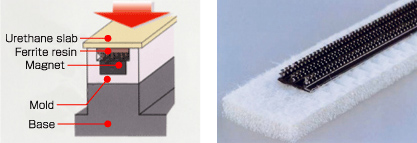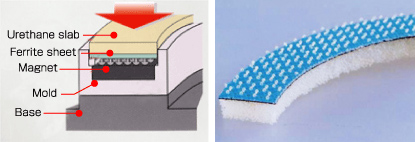News
Kuraray Co., Ltd. has been marketing car seat cover fasteners since 1996, but has recently developed new "magnet type" and "magnet perforation type" fasteners that have greatly improved functionality and are simple to use even on seats with complex shapes. The Company is now marketing these fasteners to automobile manufacturers.
The system previously marketed by Kuraray reduced the labor involved in assembly and made it easy to separate urethane cushions from seat cover material when recycling. This system, highly regarded since its introduction in 1996, allowed a 60% weight reduction in comparison with systems using metal wire. This not only contributed to the reduction of metal use in automobiles, but also allowed significant cost reductions and increased efficiency of manufacturing processes through automation of the fastening process.
Car seats are assembled by covering urethane cushions with fabric or leather. To the present, most car seat assembly involved fastening the seat cover material in place by piercing both the cushion and the cover material with metal wire, and fastening the wire to rings. This is called the "hog ring" method.
This method requires not only skill but also physical strength, as the use of the hog ring gun to fasten the wire to the hog rings is physically demanding. In addition, the Automobile Recycling Law that will come into effect in 2004 will require the strict separation of urethane cushions from seat cover materials at disposal.
Existing methods require a large number of fasteners and a good deal of time to cover car seats of complex shape. Kuraray has developed the "magnet type" method, which sets the fasteners easily using strong magnetic force, to reduce the time required. This product can be made narrower without any loss of strength. Therefore, covers can be pleated for a high-quality feel. Kuraray also markets the "magnet perforation type" system, which allows a three-dimensional "slit" shape seat cover.
These new products are ideal for the increasingly high-quality and complex designs of today's car seats, and will facilitate the waste sorting that will become mandatory in 2004. Seats assembled using these systems are lighter in weight and use less metal, which is responsive to environmental concerns, while the increased efficiency of manufacturing processes results in significant cost reductions.
Kuraray is working to have these products incorporated into new car seat assembly systems.
Specifications of the new products are as below :
(1) Characteristics :
- 1. Magnet Type (Figure 1)
-
- The molded polypropylene fastener element is coated with ferrite resin, and the magnetism of a magnet set in the mold cures the resin.
- To prevent liquid urethane foam from running onto the operating portion of the fasteners, a three-layer construction of the molded fastener, bonded fabric, and a special urethane slab is utilized.
- 2. Magnet Perforation Type (Figure 2)
-
- Fasteners are laminated into a ferrite sheet and a special urethane slab 1m 46cm wide. This width allows perforations to be made in sufficient quantity and in such positions as to facilitate the covering of varied and complex seat shapes.
(2) Engaging strength (with special loop material)
| Existing products(13mm) | Magnet type(7mm) | |
|---|---|---|
| Engaging strength | 1.3 | 1.2 |
(kg/width)
(Values measured by Kuraray)
(3) Cost of production (deliverable, exclusive of consumption tax)
- 1. Magnet type:¥50/m
- 2. Magnet perforation type: ¥15/sheet (300r x 300mm long)
- * Loop material is exclusive of the prices stated above.
(4) Availability
From August 18, 2003
(5) Projected sales
| Initial year | Magnet type ¥50 million Magnet perforation type ¥50 million |
|---|---|
| After 3 years | Magnet type ¥150 million Magnet perforation type ¥200 million |
 Figure 1: Magnet type
Figure 1: Magnet type
 Figure 2: Magnet perforation type
Figure 2: Magnet perforation type
